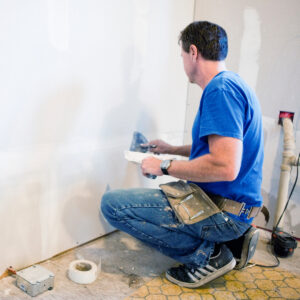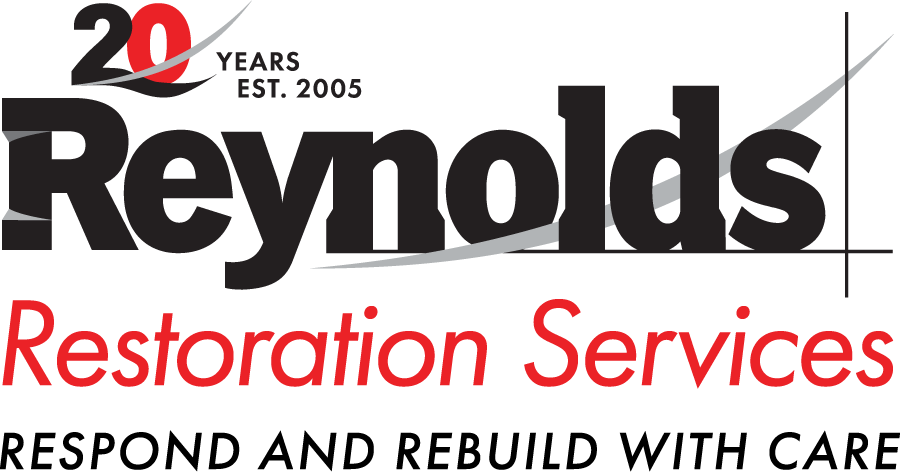
Do you know how to repair water-damaged drywall in your home? Let’s take a look at what causes it, what signs to look for, and the steps to take to fix damaged drywall easily.
Causes of Drywall Water Damage
Like other types of water damage, drywall water damage is caused by a sudden water exposure in your home. The most common causes of drywall water damage include:
- Plumbing Leaks: Plumbing leaks are nearly impossible to predict and can take a homeowner by surprise. Leaking pipes near faucets or showers, ruptured hose lines in appliances, faulty air conditioning units, and even broken hot water tanks can all lead to drywall water damage. As part of your regular home maintenance routine, it’s a good idea to visually inspect your plumbing system to look for potential risks.
- Foundation and Structural Failures: Foundation and structural failures are a very common cause of drywall water damage. When the ‘bones’ of your home start to fail – whether it’s the roof, walls, or foundation – water can seep in and cause damage.
- Storms, Floodwaters, and Other Severe Weather: Torrential rain can be a direct cause of damaged drywall. When your home cannot divert water away efficiently, or your gutters and downspouts or clogged or can’t keep up with the amount of falling rain, the water can get into your home and affect drywall. It’s good practice to clean your gutters several times a year, especially during the spring and summer when leaves and other debris tend to get trapped in your gutter system.
If you have damaged drywall from a plumbing leak, foundation or structural failure, or from a recent storm or flood, it’s important to tackle the issue quickly to avoid further damage and prevent mold growth from occurring. While many homeowners may be able to tackle the task on their own, a professional restoration services company can address the water-damaged drywall quickly and efficiently and can help identify the source of the water damage.
Signs of Water Damage on Drywall
Unsure if your drywall is water damaged? The signs are fairly easy to see if you know what to look for. To stay ahead of extensive water damage at your home or business, here are some key things to look for that indicate you have water-damaged drywall:
- Discoloration/Fading: If you see patches of discoloration, fading, or water stains on your ceiling or walls, this is a prime indication you have water damage. While it may be tempting to just paint over the discoloration, it does not address the cause of the water damage itself. Before attempting any repair work, find the source of the water leak and fix it first.
- Peeling Paint or Wallpaper: When drywall gets wet, the water evaporates through the material and can lift paint and wallpaper off of it. If you have areas in your home where you see small patches of paint or wallpaper beginning to peel, this is a huge red flag you are experiencing water issues.
- Musty Odor: If you start to smell a musty or moldy odor in your home, the likely culprit is water damage. When drywall materials like plywood, wood pulp, and gypsum get wet, mold can begin to grow and cause an odor. Mold can be dangerous to homeowners, so if you smell a musty or moldy odor, consider engaging with a professional mold remediation company before the issue gets worse.
- Saggy Drywall: Sagging drywall is a very easy way to tell if it has become water damaged. When it’s dry, it is rigid and firm. When drywall gets wet, the materials begin to droop and sag.
Notice any of these signs in your home? You likely have a water leak. For small areas with wet drywall, you may be able to repair it yourself. What are the steps to repair water-damaged drywall?
Steps to Repair Water Damaged Drywall
If you are comfortable with minor DIY projects, wet drywall repair should be easy and straightforward. Before you begin, make sure you have the proper protective equipment and materials needed.
- Find the Leak: First and foremost, you want to identify why the drywall is damaged. Once you find the leak or issue, focus on fixing this before you do anything else. If you ignore the cause and repair the damaged area, it’s almost a guarantee you will have repeat damages in the future.
- Remove Water-Damaged Drywall: Once you’ve identified and fixed the water leak or issue, you should remove the damaged drywall. Using a utility knife, cut out the damaged area. Remove the insulation from behind the hole, even if it doesn’t look or feel wet. If the drywall was wet, you can assume the insulation was wet too.
- Remediate Mold: Mold needs a cool, damp space to thrive, and a food source like drywall and wood to grow. Before patching up the damaged drywall, check for and remediate any mold issues.
- Replace Damaged Drywall: Once you’ve removed the damaged drywall and addressed any mold issues, it’s time to replace the damaged area. Measure the size of the hole so you know how much to cut out of a new sheet of drywall. Secure the new piece of drywall to the damaged area with drywall screws.
- Seal and Paint: The last step in the process is to seal and paint the new area. Fill the seams with drywall mud and use sandpaper to blend the new area with the old area. When everything is dry, prime the area and then apply paint. Note: you may have to repaint the entire wall or ceiling to ensure the color is uniform over the entire space.
Water Damage Restoration Specialists
Reynolds Restoration Services is the premier commercial and residential emergency restoration services company in the mid-Atlantic region. With three offices to serve our customers – Harrisburg, Pa., Philadelphia, Pa., and the greater Baltimore, Md./Washington, D.C. region, our team of emergency mitigation professionals can be on-site quickly to help with water damage issues.
We are on call 24 hours a day year-round to respond to water damage, fire damage, storm damage, and other emergencies. With more than 15 years of experience, you can trust our team to get the job done right and restore your home to its pre-loss condition after an emergency. Struggling with water-damaged drywall? Call us today at 1.888.277.8280.

President of Reynolds Restoration Services. Over 20 years of experience in the emergency restoration industry.

